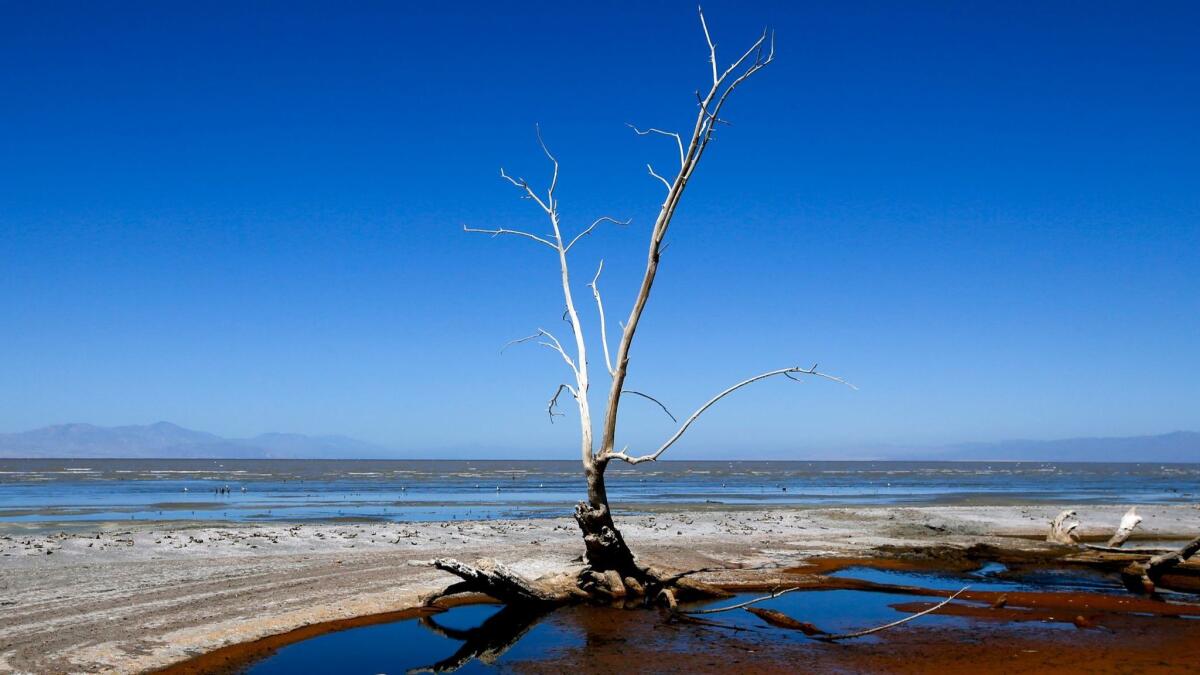Riverside County has a new plan to fix the Salton Sea — or at least a part of it

- Share via
Riverside County officials on Thursday unveiled a possible $400-million remedy for some of what ails the shrinking Salton Sea: record-high salinity levels, die-offs of fish, fewer birds and an immense “bathtub ring” of smelly playa prone to toxic dust storms.
The so-called North Lake Vision proposed by Riverside County Supervisor Manuel Perez calls for creation of an in-lake barrier, or dam, on the north end of the sea that would be filled with enhanced flows from the White Water River to create what he described as “a 4,200-acre healthy lake within a much larger not-so-healthy one.”
By way of comparison, the proposed “North Lake” in the desert would be roughly twice the size of Big Bear Lake, which supports several popular alpine resort communities in the San Bernardino Mountains, about 138 miles to the northwest.
The plan, pending approval by the Riverside County Board of Supervisors, would be subsidized with taxes generated by a bond measure that may be presented to voters within a year, officials said.
Perez’s proposal grew out of frustration and anger over seemingly endless disputes with the state over its inability to complete Salton Sea restoration projects even as environmental conditions steadily deteriorate at California’s largest and most troubled lake.
“I haven’t seen any meaningful action on behalf of the state to try and implement any of the plans it has proposed over the past 20 years,” Perez said. “Our proposal is an attempt to salvage what we can of Riverside County’s portion of the Salton Sea.”
“While the North Lake Vision is no cure for worsening problems elsewhere in the Salton Sea,” he added, “our hope is that the state will take a hard look at our efforts and prioritize their own projects.”
The state projects are regarded as the first phase of a proposed long-term Salton Sea restoration program. They include building a series of ponds and water-transfer systems across about 29,000 acres mostly on the southern end of the sea in Imperial County, officials said.
In 2016, the state Legislature approved $80.5 million for Salton Sea projects.
But critics point out that it remains unclear how the state plan will be funded and whether the state can be held accountable if it fails to make good on its commitments to protecting public health and habitat at the 360-square-mile lake straddling Riverside and Imperial counties.
Officials said state, federal, regional, tribal and philanthropic agencies would continue to seek funding in their long-term effort to protect air quality and wildlife at the Salton Sea at an estimated cost of as much as $8 billion.
“If we clean up the north end of the Salton Sea, it will only grow as a unique asset in the Coachella Valley,” Brian Nestande, deputy executive officer for Riverside County, said. “And it will thrive as a fantastic place to go kayaking, bird-watching and fishing, as well as hiking in stark desert terrain.”
The Riverside County Board of Supervisors is expected within a few months to decide whether to create an enhanced infrastructure finance district to fund the North Lake proposal. If approved, county voters in that district could within a year be presented with a bond measure aimed at funding the project, officials said.
Perez acknowledged that there are “still a lot of unknowns” in his proposal, including exactly who owns water rights to White Water River flows out of the San Bernardino Mountains and whether sediment at the bottom of the Salton Sea can support a huge structure.
The Imperial Irrigation District was unavailable for comment. But Andy Horne, deputy executive officer for Imperial County, expressed cautious optimism.
“There’ve been similar proposals floated in the past,” Horne said. “If they can demonstrate it’s a workable concept, more power to them.”
The Salton Sea was formed accidentally in 1905 when the Colorado River breached its banks. One of the most important wetlands along the Pacific Flyway, it supports nearly 90% of the nation’s American white pelicans and 90% of its eared grebes.
But with little water flowing in, salinity levels continue to rise. They are now at about 59 parts per thousand, federal reclamation authorities said. By comparison, the salinity level of the Pacific Ocean is about 35 parts per thousand.
That has made the lake inhospitable to tilapia, a primary food source for migrating birds, which has all but stopped reproducing because of high salinity levels. Visiting bird populations are a fraction of what they once were.
The latest political trouble at the Salton Sea began in 2003, when the state Legislature promised to slow the shrinking of the lake as part of a successful effort to persuade the Imperial Irrigation District to sell some of its water to San Diego.
The agreement allowed the Imperial Irrigation District to stop directing water into the Salton Sea at the end of 2017. Now, with even less fresh water entering the lake, critics worry that a toxic brew of salt laced with pesticides and particulates small enough to be dangerous to human health will be picked up by the wind and dispersed throughout neighboring Imperial and Coachella valleys, and beyond.
“We don’t have all the answers,” Perez said. “But our proposal is doable and a good start.”
More to Read
Sign up for Essential California
The most important California stories and recommendations in your inbox every morning.
You may occasionally receive promotional content from the Los Angeles Times.














